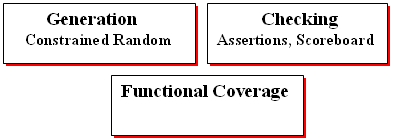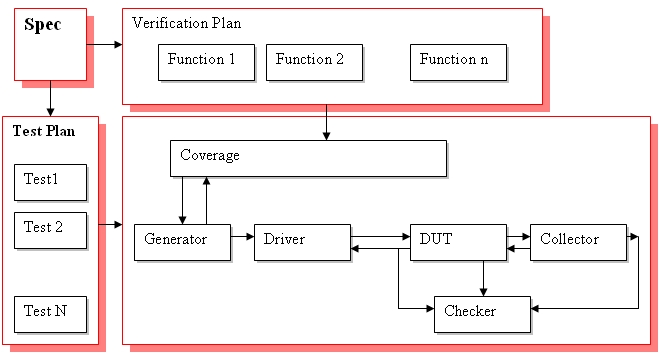|
What is SystemVerilog?
SystemVerilog is the most transformative technology in EDA since the birth
of logic synthesis.
It is an extension of the popular Verilog language, bringing a higher
level of abstraction to design and verification.
SystemVerilog provides a complete verification environment, employing
Constraint Random
Generation, Assertion Based
Verification and Coverage Driven Verification.
These methods improve dramatically the verification process. SystemVerilog
also provides enhanced hardware-modeling features, which improve the RTL
design productivity and simplify the design process.
Who should use
SystemVerilog?
SystemVerilog is extremely scalable. It can be used by both HW designers
and Verification engineers; SystemVerilog can be used as part of your
Verilog or VHDL Test Bench (TB) environment, as part of
your design or as an
external module. For example, a designer can enjoy the power of the Random
Generation by simply including some of the SystemVerilog Random features
in the current TB with no need to change the entire verification
environment.
In the same way the
verification engineer may include some assertions to verify correctness of
a bus or a protocol as part of the existing full chip simulation.
How to use
SystemVerilog?
SystemVerilog is an
integrated part of the Simulation tool. There is no need for any external
tool, GUI or interface (such as PLI) in order to run it. There is no need
for any new compilation commands.
Therefore, the
adoption process of SystemVerilog is very fast causing designers to find
it very friendly and easy to use.
Among the benefits of this
unified environment is the overall performance. Running Verification using
SystemVerilog is at least x2 faster than with any other verification
languages, which requires external interface to the simulation tool.
What are the advantages
of SystemVerilog Vs. other Verification Languages?
SystemVerilog has several
key advantages that involve standardization, performance and adoption by
engineers.
� SystemVerilog was adopted
as a standard by the Accellera organization, and is currently in the
process of final approval by IEEE. This ensures a wide embracing and
supported by multiple vendors of EDA tools and verification IP's, as well
as interoperability between different tools and vendors.
� Since SystemVerilog is an
extension of the popular Verilog language, the adoption process of
SystemVerilog by engineers is extremely easy and straightforward.
SystemVerilog enables engineers to adopt a modular approach for
integrating new modules into any existing code. As a result, the risks and
costs of adopting a new verification language are reduced.
� Being an integrated part
of the simulation engine, eliminates the need for external verification
tools and interfaces, and thus ensures optimal performance (running at
least x2 faster than with any other verification languages).
SystemVerilog
verification methodology
The SystemVerilog
verification methodology relies on 3 building blocks, which can be used
separately, or all together:
�
Stimuli
the design using
automatically generated random scenarios - constrained-random (CR)
test generation.
�
Check
the behavior of the design
(assertions) and the output data (scoreboard) to verify
correctness of operation.
�
Measure
the functional coverage
metrics to provide feedback to the generation and analyze progress of
verification.

Applying the above methods
that include iterative process of simulation, debug and coverage
measurement is known as Coverage Driven Verification.
The goal of a Coverage
Driven Verification methodology is to maximize verification effectiveness
and at the same time, minimize redundancy and ineffective verification
work.
The SystemVerilog language
contains commands and constructs to support CDV including commands for
constraint-random generation, assertions and functional coverage
measurement.
Measuring coverage is a
critical component of the CDV methodology. The SystemVerilog coverage
measurement commands (like covergroup and coverpoint) provide feedback
regarding the completeness of the verification process and guide the next
steps of verification so that effort and resources are applied to improve
overall verification.

What is the
SystemVerilog�s contribution to the RTL design?
SystemVerilog brings a higher level of abstraction to the Verilog
designer. Constructs and commands like Interfaces, new Data types (logic,
int), Enumerated types, Arrays, Hardware-specific always (always_ff,
always_comb) and others allow modeling of RTL designs easily, and with
less coding.
SystemVerilog also extends
the modeling aspects of Verilog by adding a Direct Programming Interface
which allows C, C++, SystemC and Verilog code to work together without the
overhead of the Verilog PLI.
Is the SystemVerilog
ready for use?
The answer to that question
is a resounding YES!
Many experts from EDA
companies and the Verilog user community that participated in the
development of the SystemVerilog standard have put lots of efforts in
bringing this useful language to the market.
SystemVerilog is unifying
the best of their learning from many different languages into a practical,
easy-touse solution that everyone can rally around.
Click here to read SystemVerilog Tutorial:
|